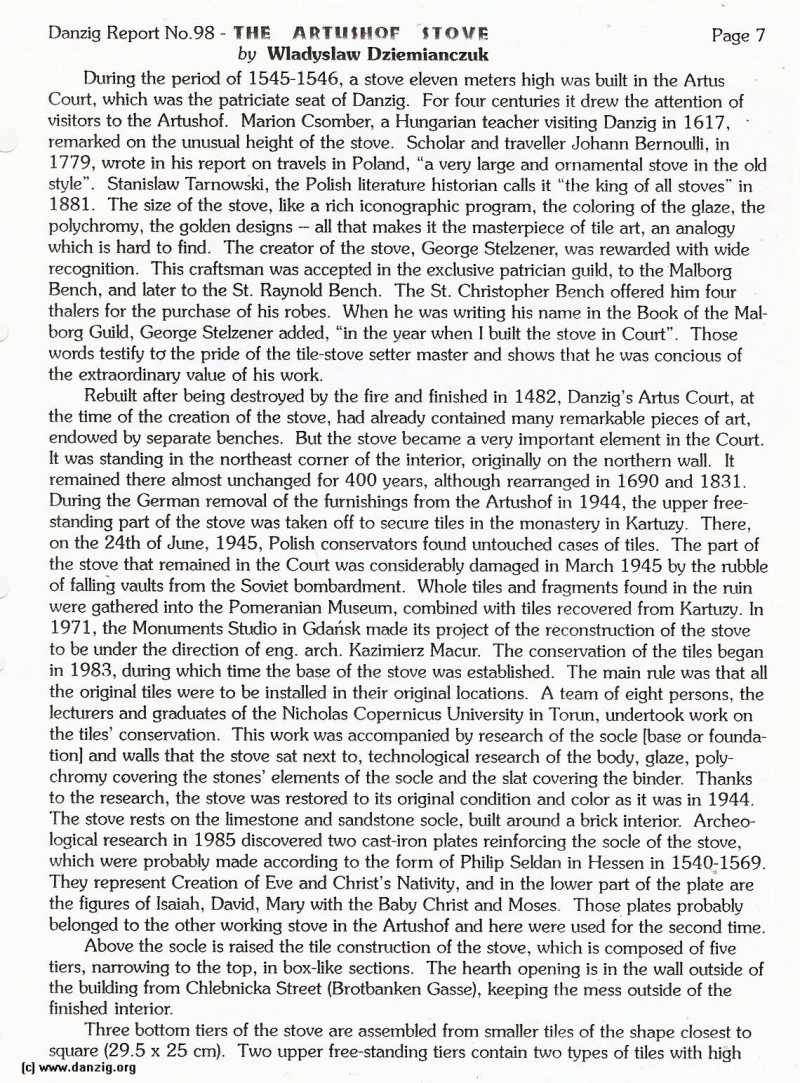
THE ARTUSHOF STOVE by Wladyslaw Dziemianczuk
During the period of 1545-1546, a stove eleven meters high was built in the Artus Court, which was the patriciate seat of Danzig. For four centuries it drew the attention of visitors to the Artushof. Marion Csomber, a Hungarian teacher visiting Danzig in 1617, remarked on the unusual height of the stove. Scholar and traveller Johann Bernoulli, in 1779, wrote in his report on travels in Poland, “a very large and ornamental stove in the old style”. Stanislaw Tarnowski, the Polish literature historian calls it “the king of all stoves” in 1881. The size of the stove, like a rich iconographic program, the coloring of the glaze, the polychromy, the golden designs — all that makes it the masterpiece of tile art, an analogy which is hard to find. The creator of the stove, George Stelzener, was rewarded with wide recognition. This craftsman was accepted in the exclusive patrician guild, to the Malborg Bench, and later to the St. Raynold Bench. The St. Christopher Bench offered him four thalers for the purchase of his robes. When he was writing his name in the Book of the Mal-borg Guild, George Stelzener added, “in the year when built the stove in Court”. Those words testify ta the pride of the tile-stove setter master and shows that he was concious of the extraordinary value of his work.
Rebuilt after being destroyed by the fire and finished in 1482, Danzig’s Artus Court, at the time of the creation of the stove, had already contained many remarkable pieces of art, endowed by separate benches. But the stove became a very important element in the Court. It was standing in the northeast corner of the interior, originally on the northern wall. It remained there almost unchanged for 400 years, although rearranged in 1690 and 1831. During the German removal of the furnishings from the Artushof in 1944, the upper free standing part of the stove was taken off to secure tiles in the monastery in Kartuzy. There, on the 24th of June, 1945, Polish conservators found untouched cases of tiles. The part of the stove that remained in the Court was considerably damaged in March 1945 by the rubble of falling vaults from the Soviet bombardment. Whole tiles and fragments found in the ruin were gathered into the Pomeranian Museum, combined with tiles recovered from Kartuzy. In 1971, the Monuments Studio in Gdañsk made its project of the reconstruction of the stove to be under the direction of eng. arch. Kazimierz Macur. The conservation of the tiles began in 1983, during which time the base of the stove was established. The main nile was that all the original tiles were to be installed in their original locations. A team of eight persons, the lecturers and graduates of the Nicholas Copernicus University in Torun, undertook work on the tiles’ conservation. This work was accompanied by research of the socle [base or foundationj and walls that the stove sat next to, technological research of the body, glaze, polychromy covering the stones elements of the socle and the slat covering the binder. Thanks to the research, the stove was restored to its original condition and color as it was in 1944. The stove rests on the limestone and sandstone socle, built around a brick interior. Archeological research in 1985 discovered two cast-iron plates reinforcing the socle of the stove, which were probably made according to the form of Philip Seldan in Hessen in 1540-1569. They represent Creation of Eve and Christ’s Nativity, and in the lower part of the plate are the figures of Isaiah, David, Mary with the Baby Christ and Moses. Those plates probably belonged to the other working stove in the Artushof and here were used for the second time.
Above the socle is raised the tile construction of the stove, which is composed of five tiers, narrowing to the top, in box-like sections. The hearth opening is in the wall outside of the building from Chlebnicka Street (Brotbanken Gasse), keeping the mess outside of the finished interior.
Three bottom tiers of the stove are assembled from smaller tiles of the shape closest to square (29.5 x 25 cm). Two upper free-standing tiers contain two types of tiles with high
Danzig Report Nr. 98 - January - February - March - 1998, Page 7.
Hits: 3719
Added: 20/05/2015
Copyright: 2025 Danzig.org

